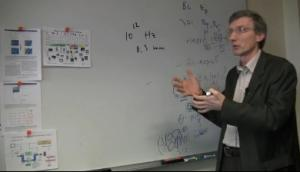"T-rays" may make X-rays obsolete as a means of detecting bombs on terrorists or illegal drugs on traffickers, among other uses, contends a Texas A&M physicist who is helping lay the theoretic groundwork to make the concept a reality. In addition to being more revealing than X-rays in some situations, T-rays do not have the cumulative possible harmful effects.

Alexey Belyanin, associate professor in the Texas A&M Physics Department. (Credit: Image courtesy of Texas A&M University)
Alexey Belyanin focuses his research on terahertz, otherwise known as THz or T-rays, which he says is the most under-developed and under-used part of the electromagnetic spectrum. It lies between microwave radiation and infrared (heat) radiation.
Belyanin, associate professor in the Texas A&M Physics Department, has collaborated with colleagues at Rice University and the National High Magnetic Field Laboratory to publish findings about their T-ray research in the journal Nature Physics.
"THz radiation can penetrate through opaque dry materials. It is harmless and can be used to scan humans," Belyanin says. "Unfortunately, until recently the progress in THz technology has been hampered by a lack of suitable sources and detectors."
Belyanin and his team have offered hope: The researchers are able to control the T-rays by varying external parameters like temperature or magnetic field, making it possible to build THz sensors, cameras and other devices.
Traditionally, powerful photons from visible or near-infrared laser pulses are used to probe semiconductors, knocking electrons out of the atoms. Belyanin and collaborators use the less powerful T-rays instead, which only excite the waves in the electron gas because T-rays do not have enough energy to knock out electrons.
"This is as if instead of throwing a stone into a tank of water, which would create a lot of splashes, we gently vibrate one wall of the tank, sending a sound wave through the body of water and ripples over its surface," he explains.
By varying temperature and the magnetic field, scientists can tune the pulses and observe the behavior of the waves.
"This provides extremely valuable and unique information about the properties of the material, just like seismic waves tell you what is in the Earth's interior," the Texas A&M physicist points out.
"The highlight of our results is observations of interference of magnetoplasmons. By tiny changes in the applied magnetic field or temperature, we can make plasma waves amplify or cancel each other. This makes the whole sample either completely opaque or transparent to the incident THz radiation."
Belyanin believes the technology has important practical implications, such as in security work.
"Using THz cameras, we could detect weapons or drugs concealed on a human body, or look inside envelopes and boxes," he says. There are many other applications for THz radiation, including material studies, chemistry, biology, medicine."
(责任编辑:董静)